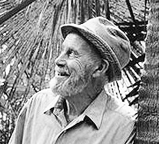
Click an Image below to Enlarge
Ray Crooke
was born in Melbourne, Victoria in 1922. He served as a map-maker during the
Second World War on Cape York Peninsula, Thursday Island in the Torres Strait,
and Borneo. One of the most important inspirations towards his later career as
a painter was, to come through, a trip by troop train from Perth across the Nullarbor
Plain to the tip of Cape York Peninsula in 1942. The ancient Australian
landscape, particularly its tropical north, had a profound impact on Crooke.
Crooke
also paints wonderful portraits, and in 1969 he won the Archibald for a
portrait of his friend, the writer George Johnston. In 1993 Crooke was
made a member of the Order of Australia for services to the visual arts.
Ray Crooke is a much loved and monumentally important Australian artist. He is
part of a milieu that includes the likes of Nolan, Drysdale and Boyd, in
that he has been able to identify and illuminate a unique quality that pervades
the Australian landscape and its inhabitants - his simple, poignant vision is
manifested through a magnificent body of work spanning more than sixty years.
After the war Crooke resumed formal art studies in etching and drawing at
Swinburne Technical College in Melbourne. He completed his studies in 1948, and
for the next decade his artistic endeavours were focused on drawing and etching
- these works being largely influenced by the work of William Blake and Samuel
Palmer. Over this period he kept detailed illustrated journals of his travels
to Thursday Island, Moa Island and the Great Barrier Reef - these were
invaluable as references for later paintings.
Crooke didn't take up painting regularly until the late 1950's, by which time
he was living on Cape York Peninsula, north of Cairns. His first major one-man
exhibition was held at Australian Galleries, Melbourne in 1959. This was
followed by one-man shows with Terry Clunes Galleries, Sydney and Skinner
Galleries, Perth in 1960. The success of these exhibitions allowed Crooke to
give up teaching and become a full time painter in 1961.
In terms of formal aesthetic influences, Crookes work is more informed by his
love of the early Italian renaissance masters Piero Della Francesca and
Giorgione, than it is by any influence from the 19th century French master Paul
Gauguin, who is the artist most popularly cited in reference to Crookes work.
Although he shares Gauguin’s love of the primitive, the tropical islanders
ethos and lifestyle, the values of simplified structure and purity of colours;
his work is more imbued with the formal, aesthetic and philosophical qualities
associated with the early renaissance. As James Gleeson was to write: "Crookes
fascination with contours and silhouette, his placement of dark shapes against
light, of dark against dark and light against light, and his dramatic tonal
leaps are all qualities which can be found in the 15th century art of Piero
Della Francesca".* It is this sensation of clear defining light that
Crooke saw in the Frescoes of Piero Della Francesca and even in the 14th
century Giotto, that is so important to his own work.
Crookes debt to Giorgione is illuminated in his own words: "....the
painting I most wanted to see in Europe would have been 'La Tempesta' by
Giorgione.....it could be that my attraction to this period of art in Europe
allowed me to appreciate the Australian landscape - especially in the Laura and
Palmer River paintings where I was able to introduce the stockman and pack
horses in place of gods and shepherds".**
For all the apparent simplicity of his painting, Crooke is a complex artist. No
line or mark or colour is there without a reason. His works are disciplined and
considered pictorial symphonies - as Gavin Wilson observes: "....it takes
time, often decades to absorb something of the essence of a place. Ray Crookes
landscape paintings have emerged from a disciplined distillation of observed
fact. The poetic metamorphosis from the topographic to the metaphysic takes
place in the solitude of the artist’s studio".*** Another perceptive
observation of Wilsons is that Crooke : "
....eschews the sentimental or heroic gesture, grounding his vision in the
monumental simplicity and laconic grace of people shaped by their
environment".****
Reflecting on his own work in 2000, Crooke wrote: "The songs are simple
ones...the beauty lies in the extemporising of the patterns, beauty begets
beauty and infects the jaded city dweller till he also wants only to lie on
some green island, where the tropic moon rises in a velvet sky and the palms
sing above the life below".*****
* Encounters with country: landscapes of Ray Crooke. www.cairnsregionalgallery.com.au/ed-encounters.pdf.
***** Bronwyn Watson, "Ray Crooke, man of the north" The Australian,
September 28, 2013
Copyright © 2008 Art Nomad. All rights reserved. Click here to view copyright statement